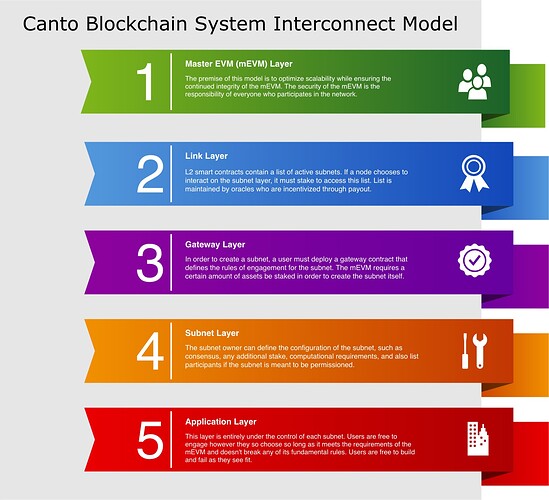Yes, you are correct. It’s similar in principle, however, there are some fundamental differences between the two. First of all, the Polkadot model is PoS based and also implies a certain degree of inherent connectivity and necessary cooperation between individual sidechains. While Canto presents a similar approach from a high-level, the intent is to provide a practical solution that can be easily implemented in a manner that requires very little additional re-architecture or development of the existing Ethereum protocol.
The Canto model is still POW based, but the subnets are logically isolated from one another and responsible for their own security and function. Assuming that a subnet is stable and consistent, we can also assume that its own transactional processing would be retained within that particular environment, thereby reducing the computational overhead required by POW on layer 1. To further expand on this notion, transactional activity on layer 1 would be limited to the result of very few actions, including subnet creation, subnet destruction, participant entry, and participant exit. This optimization could dramatically reduce the total amount of POW transactions, allowing anyone to participate as a miner without the need for commodity hardware.
The next point of difference would be that Canto’s design principles place an emphasis on consent, choice, and sovereignity, so long as the integrity of the primary layer is preserved. Each subnets has the ability to dictate its own terms of engagement. Interoperability between subnets is a choice. Consensus mechanisms are a choice. The act of joining a particular subnet, multiple subnets, or any subnet at all is a choice. The staking mechanics provide an insurance layer between the subnets and the primary EVM and also help contol liquidity.
For example, if some sort of experimental system chose to build out on a subnet, they can choose to implement whichever consensus algorithm or protocol they choose. Since the ephemeral nature of the subnets allows them to be rapidly constructed and deconstructed, the participants would still be able to experiment in a safe environment. If some sort of security issue were to present, the existing subnet could simply choose to rebuild itself as a separate subnet, similar to a forking event, however, the users would only have to change the network ID in the subprotocol to make the switch. From a more practical perspective, if an ICO were to choose to build on a subnet, they would be able to very quickly provide utility or at least an MVP.
While the microeconomics of the subnet itself could be affected, the results wouldn’t be nearly as adverse as they would be within the present system, but most importantly, because of the staking mechanics, the effects would be limited to the subnet and its participants and preserve the integrity of the primary EVM. Since the subnets are logically independent, the operations of each have no impact on any other, unless they choose to interoperate via cross-chain bridge.
There’s a lot of additional details we’ve discussed and are eager to share, but I’ll spare this post of further elaboration for the sake of brevity. Your feedback and critique is much appreciated.
